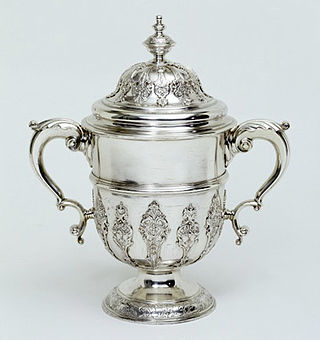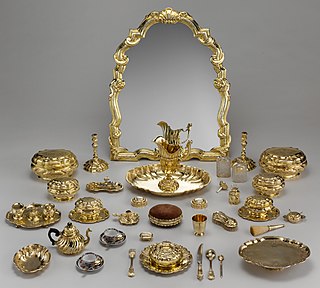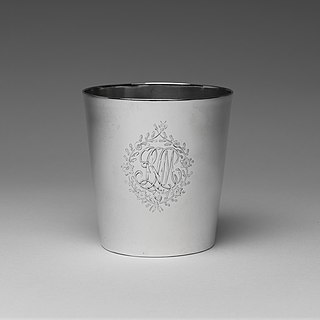Related Research Articles

Paul Jacques de Lamerie was a London-based silversmith. The Victoria and Albert Museum describes him as the "greatest silversmith working in England in the 18th century". He was being referred to as the "King's silversmith" in 1717. Though his mark raises the market value of silver, his output was large and not all his pieces are outstanding. The volume of work bearing de Lamerie's mark makes it almost certain that he subcontracted orders to other London silversmiths before applying his own mark.

A salt cellar is an article of tableware for holding and dispensing salt. In British English, the term can be used for what in North American English are called salt shakers. Salt cellars can be either lidded or open, and are found in a wide range of sizes, from large shared vessels to small individual dishes. Styles range from simple to ornate or whimsical, using materials including glass and ceramic, metals, ivory and wood, and plastic.

Household silver or silverware includes tableware, cutlery, and other household items made of sterling silver, silver gilt, Britannia silver, or Sheffield plate silver. Silver is sometimes bought in sets or combined to form sets, such as a set of silver candlesticks or a silver tea set.

Jeremiah Dummer was the first American-born silversmith, whose works are today highly valued, two items of his having sold in 2004 and 2007 both for $204,000. He was also noted as a portrait painter and as an engraver, who created the first paper currency in Connecticut Colony. His son Jeremiah Jr. was involved with the foundation of Yale University.

Colonel Edward Winslow was an American silversmith, military officer, sheriff and jurist.

Benjamin Burt was an American silversmith active in Boston, and uncle to Major Samuel Shaw, who sailed on the Empress of China (1783) as the first American consul to China.

Samuel Casey was a silversmith and counterfeiter active in Little Rest (Kingston), Rhode Island.

John Coburn was a noted silversmith active from about 1745 to 1790 in Boston, Massachusetts. Coburn was born in York, Maine, and apprenticed circa 1737 to John Edwards in Boston. He is best known for his tea-serving items, and also for silver objects for churches in Massachusetts, Connecticut, and Maine. His work is collected in the Museum of Fine Arts, Boston, and the Yale University Art Gallery.
William Henry Calhoun (1815–1865) was an American silversmith in the Antebellum South. He was trained in Philadelphia and became a jeweler in Nashville, Tennessee, where he designed silverware in the 1830s-1860s. A Grand Master of the Odd Fellows, he was arrested by the Union Army for his Confederate support in 1863. His work can be seen at the Tennessee State Museum and the Museum of Early Southern Decorative Arts.
Elizabeth Eaton was an English silversmith.
Mary Gould was an English silversmith.
Elizabeth Muns was an English silversmith.

Anne Smith was an English silversmith working in partnership with Nathaniel Appleton.

Cary Dunn was an American silversmith, active in New York City and New Jersey.

Joseph Edwards Jr. was an American silversmith, active in Boston.

Daniel Parker was an American silversmith, active in Boston.

Apollos Rivoire, often known as Paul Revere I, was a French-American Huguenot silversmith, active in Boston. He was father to Paul Revere, the famous American silversmith and patriot.

Samuel Edwards was an American silversmith, active in Boston.

Jacob Hurd was a leading American silversmith, active in Boston, and father to silversmiths Nathaniel Hurd (1729-1777) and Benjamin Hurd (1739-1781), as well as grandfather to Benjamin Hurd Jr. (1778-1818).
Adda "Andy" Thyra Elise Louise Husted-Andersen was a Danish-born American Modernist jeweler, silversmith, metalsmith, and educator. She was a co-founder and the president of the New York Society of Craftsmen from 1941 to 1944. She was a master of working with enamel, silver and gold. She was active in New York City and Copenhagen.
References
- 1 2 Glanville, Philippa; Goldsborough, Jennifer Faulds (1990). Women Silversmiths, 1685–1845: Works from the Collection of the National Museum of Women in the Arts . Thames & Hudson. ISBN 978-0-500-23578-2. OCLC 22434893 – via Internet Archive.
- ↑ "Pair of saltcellars - Mary Rood". Metropolitan Museum of Art . Archived from the original on 30 January 2024. Retrieved 9 March 2019.
- ↑ "Trencher Salt". Museum of Fine Arts, Boston . 3 February 2019. Archived from the original on 30 January 2024. Retrieved 9 March 2019.
- ↑ Alcorn, Ellenor M. (1993). English Silver in the Museum of Fine Arts, Boston: Silver from 1697 including Irish and Scottish silver. Museum of Fine Arts, Boston. pp. 108–109. ISBN 9780878463732. OCLC 29628138 – via Google Books.
- ↑ "Mary Rood 1723 pair of silver trencher salts, eight sided with lion coat of arms". Bidsquare.com. Archived from the original on 31 January 2024. Retrieved 9 March 2019.
- ↑ "Magnificent And Rare Pair Of George Ii Silver 'trencher' Salt Dishes, Mary Rood, London 1725". Sellingantiques.co.uk. Archived from the original on 31 January 2024. Retrieved 9 March 2019.
- ↑ "A pair of 18th century silver salt cellars, mark of Mary Rood, London 1722". Bukowskis . 9 April 2017. Archived from the original on 31 January 2024. Retrieved 9 March 2019.